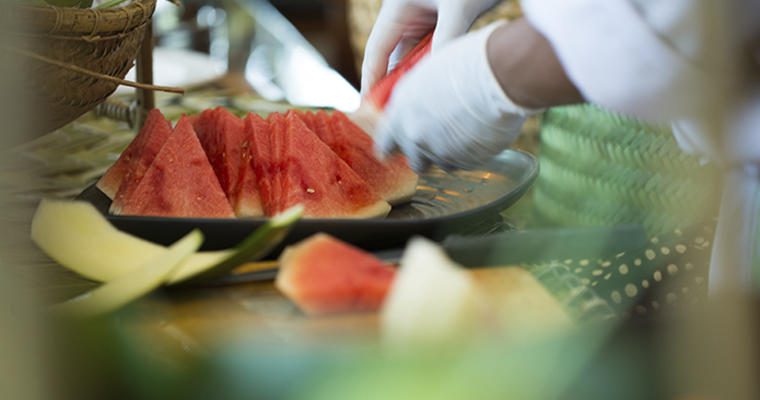Now that we are in the heat of summer it is important to think about foods that require Time and Temperature Control for Safety (TCS foods). What traditionally makes these foods dangerous is that they contain protein, are moist and have a neutral or slightly acidic pH, great growing conditions for bacteria. At the right temperature, these foods create harmful microorganisms or toxins that rapidly reproduce, leading to foodborne illnesses, most common of which are Salmonella and E. Coli.
Oftentimes, when people think about Salmonella or E. Coli, they associate outbreaks with meat and eggs. But certain plant-based foods, like cut melons and tomatoes, can pose a risk as well, which is why they are also categorized as a TCS food.
The Complete List of TCS Foods
- Meat
- Milk
- Eggs
- Fish
- Shellfish
- Meat alternatives
- Cut melons, tomatoes and leafy greens
- Untreated garlic-and-oil mixtures
- Raw sprouts
- Baked potatoes
- Cooked Rice
Raw sprouts
Sprouts need warm conditions to grow. Unfortunately, those warm and humid conditions are also perfect for bacterial growth. In fact, there have been 30 reported outbreaks of Salmonella and E. Coli related to sprouts since 1996. The seed is usually the source of bacteria. To be safe, consider avoiding raw sprouts on sandwiches and other foods. If you want to include sprouts on your menu, cook them to kill the harmful bacteria.
Sliced melon
Once the protective rind of a melon is broken, bacteria can grow exponentially, because the flesh is the perfect pH for bacterial growth. Because sliced melon is most commonly served raw, these bacteria are unlikely to be killed through cooking, and can cause serious foodborne problems for consumers. Reduce the risk with these tips:
Wash. Before slicing a melon, wash the exterior. Carefully inspect the melon for punctures or irregularities in the rind.
Slice safely. Make sure to slice the melon on a properly cleaned surface, preferably far away from any raw chicken or meat.
Refrigerate. Keep the sliced melon below 41°F (5°C) until ready to serve.
Cut tomatoes
Tomatoes are not usually a food people worry about because they are quite acidic and don’t support the “traditional” environment for bacteria growth. However, once tomatoes are cut they need to be refrigerated, because Salmonella can grow on the exposed flesh. In fact, out of all the produce-related outbreaks of Salmonella reported to the FDA from 1998-2006, 17% of them were from tomatoes.
Refrigerating cut tomatoes prevents Salmonella from growing. But if you don’t want to take up space in your operation’s fridge, another simple solution is to increase the acidity by storing cut tomatoes in vinegar or lemon juice. As long as the PH is below 4.2, they no longer pose a threat.
Cut leafy greens
Cut leafy greens are another product that needs to be stored in the refrigerator to decrease bacterial growth. Studies have shown the survival and growth of E. Coli O157:H7 decreases at lower temperatures and increases at higher temperatures. If you have a salad bar, make sure the cut greens are over ice and the temperature is not within the danger zone of 41°F to 135°F (5°C to 57°C).
No matter what TCS foods you’re serving, it’s important to note that certain populations are at a greater risk of getting sick, namely: children, elderly, pregnant women and anyone with a weakened immune system.











